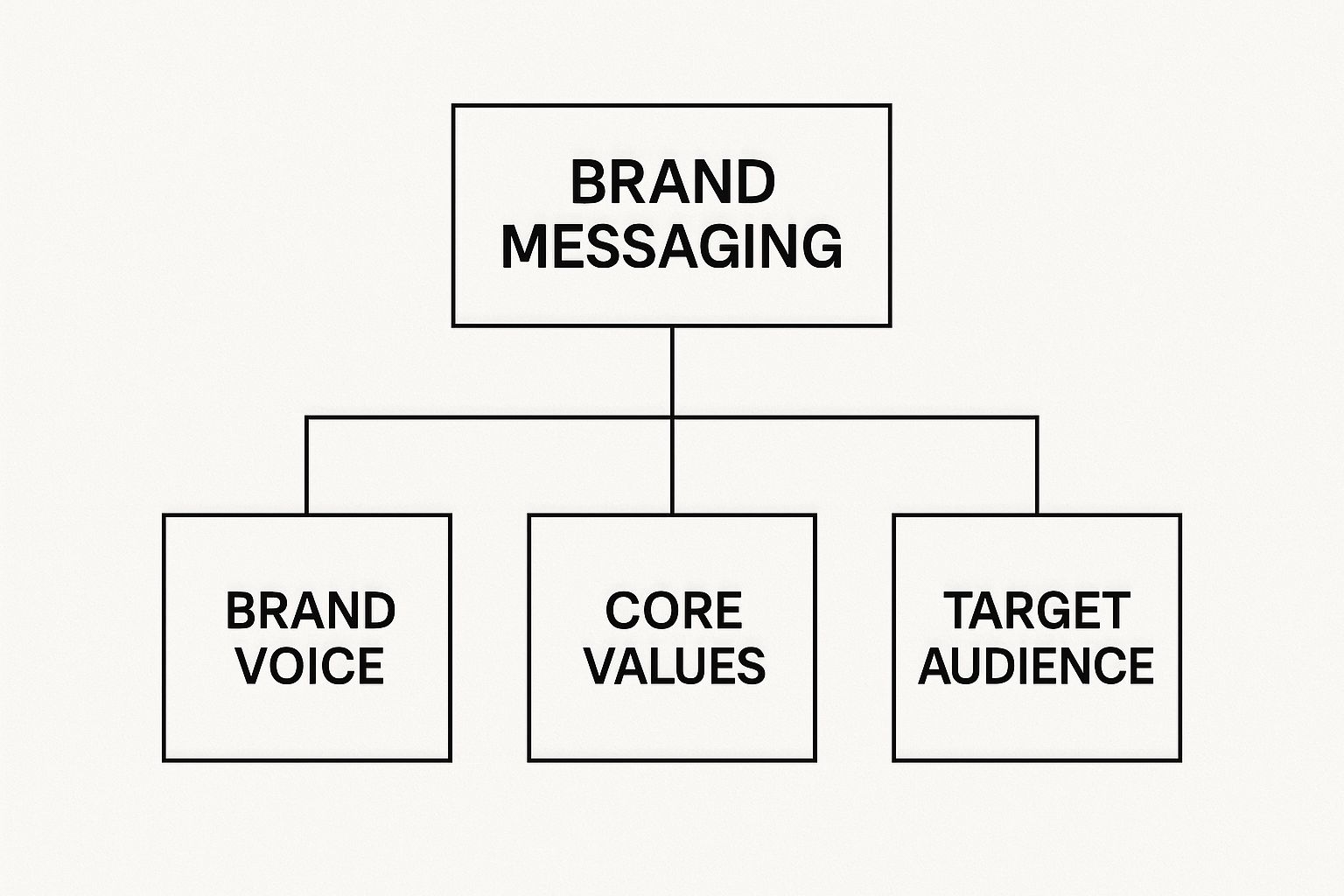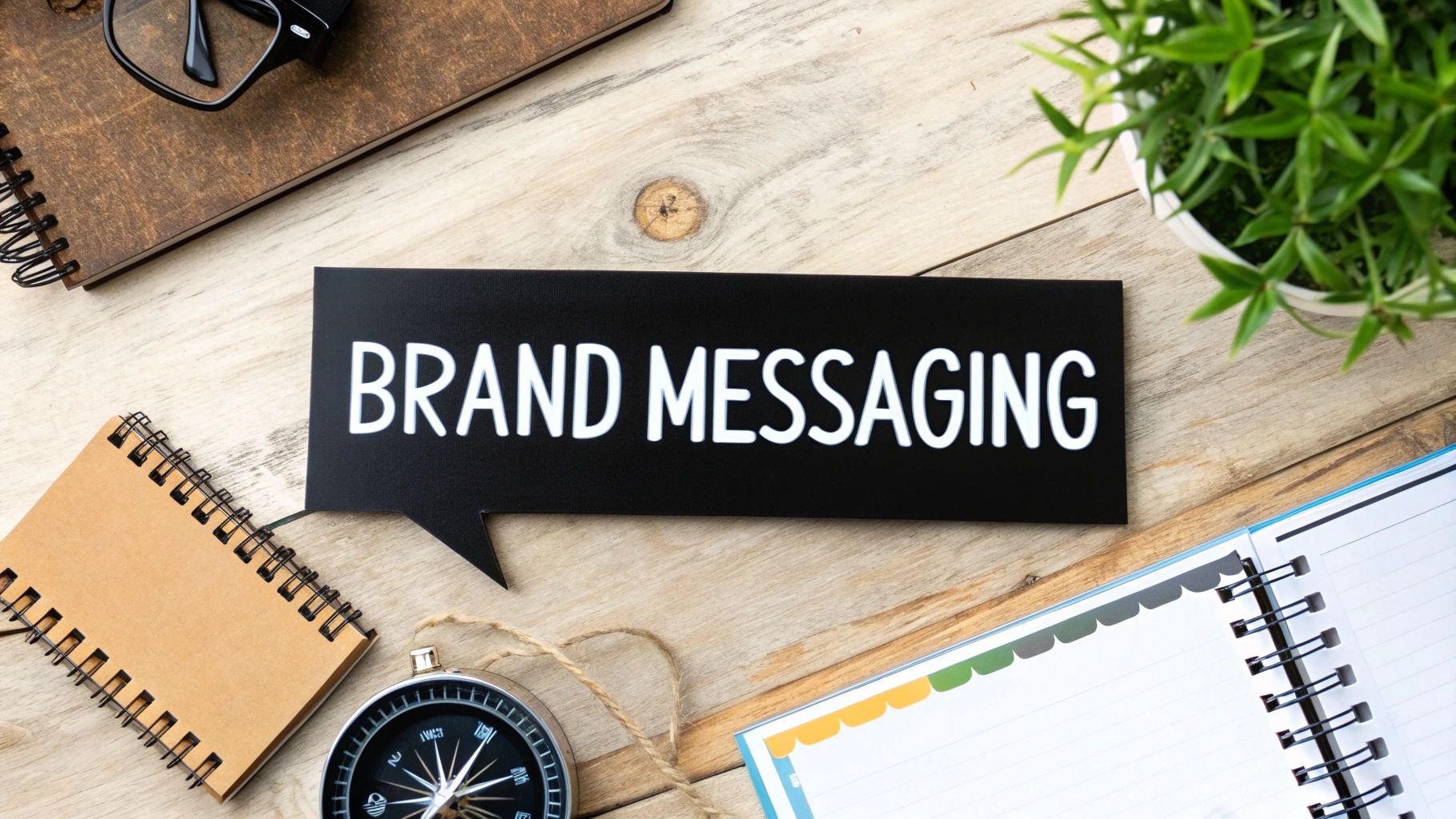Think of brand messaging as your brand's voice. It’s the way you talk, the stories you tell, and the ideas you stand for. If your brand were a person, this would be its distinct personality and core beliefs, showing up consistently everywhere—from your website copy to your social media posts and customer service emails.

What Is Brand Messaging Anyway?
Brand messaging is more than just a snappy tagline or some clever ad copy. It's the foundational language that answers the big questions: Why does your company exist? Who do you serve? And what truly sets you apart? It acts like a compass for your entire organization, making sure every single piece of communication points in the same direction.
Without it, you’re just making noise. But with a clear message, you start to build a recognizable identity that people can actually connect with and trust. This strategic approach is a powerful engine for growth. In fact, comprehensive branding research shows that companies with strong, consistent branding strategies grow 24% faster on average than their competitors.
The Purpose of a Clear Message
A well-crafted message does so much more than just sell things. It’s a guidepost for your entire company, keeping your internal teams aligned while shaping how the outside world sees you. It's the essential bridge connecting what your business wants to achieve with what your customers truly need.
Effective messaging is the foundation of a strong brand. It helps you:
- Build Trust: Consistency breeds familiarity and reliability. When what you say and do is always aligned, customers learn to count on you.
- Create Recognition: A unique and memorable message helps you stand out in a sea of competitors. It makes you unforgettable.
- Drive Loyalty: People are drawn to brands that reflect their own values. Clear messaging puts your values front and center, creating a powerful connection.
- Guide Decisions: Internally, it provides a solid framework for everything from product development to the content you create.
A strong message doesn't just sell a product; it sells a promise. It tells customers what to expect from you every single time they interact with your brand, which is the foundation for building lasting relationships.
When your messaging hits the mark, it directly boosts your company's perceived value—a critical asset for any business. You can explore this concept further in our guide explaining what is brand equity.
Core Functions of Brand Messaging
To put it simply, brand messaging plays a few key roles that are absolutely essential for building a successful brand. The table below breaks down its most important jobs.
Each of these functions works together to create a message that not only gets noticed but also builds the kind of brand that people want to support for the long haul.
Why Consistent Messaging Builds Stronger Brands

Think about your favorite coffee shop. You go back because you know exactly what you’re going to get: the same great coffee, the same friendly vibe. Consistent brand messaging works the same way. It turns a jumble of marketing efforts into a single, reliable voice that people learn to recognize and, more importantly, trust.
When your message is the same everywhere—from your website copy and social media to the way your support team talks to customers—you’re building a predictable and dependable brand. This isn't just about repeating yourself; it's about being reliable. It’s what separates a brand that feels solid and professional from one that feels chaotic and all over the place.
Fostering Trust Through Reliability
In business, trust is everything. In fact, research shows that over 81% of consumers say they need to trust a brand before they’ll even consider buying from it. If your messaging is inconsistent, you’re actively chipping away at that trust.
Imagine a brand that's funny and informal on TikTok but cold and corporate in its emails. This kind of split personality is confusing. It leaves customers wondering who you really are. A unified message, on the other hand, shows you're confident in your identity and what you stand for.
This sense of reliability makes customers feel secure. They know what to expect from you, which is the cornerstone of any strong relationship. For anyone just starting out, building a clear brand strategy for startups is crucial for establishing that trust right from the beginning.
Driving Recognition and Loyalty
How do you make a brand unforgettable? By showing up with the same core personality and ideas, time and time again. When your messaging is cohesive, you reinforce who you are at every turn, making it much easier for people to remember you in a sea of competitors.
This consistency delivers some major wins for your business:
- Improved Brand Recall: A steady voice and message make your brand instantly recognizable, whether it's an ad, a post, or an email.
- Stronger Customer Alignment: A whopping 71% of consumers prefer to buy from brands whose values align with their own. Consistent messaging makes your values clear, attracting the right crowd.
- Increased Loyalty: When customers feel a real connection to your brand, they don't just buy once—they become loyal fans and advocates.
Consistency isn’t about being boring or saying the exact same thing everywhere. It’s about ensuring your core message—your "why"—is the common thread woven through everything you say and do. No matter the channel or format, that thread holds the entire brand experience together.
At the end of the day, a brand that "sings from the same song sheet" is one that builds a dedicated following. Define your message, stick to it, and you'll create a powerful asset that builds trust, boosts recognition, and fuels long-term growth.
The Four Pillars of Powerful Brand Messaging
Truly effective brand messaging isn't just a collection of catchy phrases or lucky guesses. It’s built on a solid foundation of four core pillars, each one connected to the others. Getting these right is the key to crafting a message that feels authentic, stays consistent, and actually works.
Think of it like building a table. If one leg is wobbly, the entire structure is unstable.
Pillar 1: Your Value Proposition
Your value proposition is the simple, clear promise of value you make to your customers. It directly answers their biggest question: “Why should I buy from you instead of someone else?” This isn't about listing features; it's about the real-world solution or benefit that makes you the obvious choice for their specific problem.
A great value proposition is incredibly specific and focuses on the outcome. For instance, instead of a generic claim like, “We sell fast web hosting,” a much stronger proposition would be, “We help small businesses boost sales with a website that loads in under one second.” See the difference? It highlights the unique benefit, not just the service itself.
Pillar 2: Your Mission Statement
If your value proposition is the "what," then your mission statement is the "why." This is your reason for existing beyond just turning a profit. It’s a short, action-focused statement that explains your core purpose to your team and the world. A powerful mission acts as a compass, guiding every decision your company makes and inspiring everyone involved.
A mission isn’t about being “the best in the industry.” It's about the impact you want to create. A mission like, “To make sustainable living accessible to every family,” is far more compelling. It sets a clear direction and gives people a purpose to rally behind.
The diagram below shows how these elements come together with your core values and audience understanding to build your brand messaging framework.

This visual really clarifies how your brand's voice and values must be filtered through a deep understanding of your target audience to create messaging that hits the mark.
Pillar 3: Your Vision Statement
While your mission is about what you do today, your vision statement is about where you’re headed tomorrow. This is your big, ambitious declaration of what the future will look like if you succeed. Your vision should be aspirational—it should paint a picture that motivates your team and gets customers excited to be part of your journey.
Your vision is your ultimate destination. It’s the north star that keeps everyone moving in the same direction, even as markets, technologies, and customer needs change over time.
A strong vision statement creates a shared purpose. Just look at Tesla's goal to “accelerate the world’s transition to sustainable energy.” It’s a massive, bold ambition that defines their long-term direction and influences every single thing they do.
Pillar 4: Your Brand Voice
Finally, your brand voice is all about how you say what you say. It’s the distinct personality that comes through in all your communications. Are you witty and informal? Authoritative and serious? Warm and encouraging? Direct and to the point? Whatever you choose, your brand voice needs to be consistent everywhere, from your website copy and social media posts to your customer service emails.
Your voice is what makes your brand feel human and relatable. It’s not just the words you choose, but the tone, style, and attitude behind them. Nailing this pillar ensures your message doesn't just get heard—it truly connects with people on a personal level.
How to Create Your Brand Messaging Step by Step
Great brand messaging doesn’t just happen by chance. It’s the result of thoughtful, intentional work—a process of making smart choices to build a voice that truly connects with the right people.
Let's walk through how to build your messaging from the ground up. The entire process hinges on one simple rule: you have to know who you’re talking to. If you try to appeal to everyone, you’ll end up connecting with no one. Your message has to be razor-sharp, aimed directly at the needs, hopes, and frustrations of your ideal customer.
Step 1: Get to Know Your Target Audience—Really Well
Before you even think about writing a single word, you need a vivid picture of your audience. This goes way beyond basic info like their age or where they live. You need to understand their world.
A great way to do this is by creating detailed audience personas. Think of these as character sketches of your ideal customer. Give them a name, a job, and a bit of a backstory. But most importantly, dig into what drives them. What are their biggest challenges? What are they trying to achieve? What keeps them up at night, and what kind of solutions are they looking for?
A powerful message doesn’t just talk at people; it speaks with them. When you show customers you understand their problems on a deep level, your brand becomes the most logical solution. That empathy is the secret to building lasting trust.
Step 2: See What Your Competitors Are Saying
Once you know your audience, it's time to eavesdrop on the conversations they're already having with your competitors. What are the other players in your field saying? Take a close look at their websites, social media channels, and ad campaigns to figure out their main messaging angles.
The point here isn’t to copy anyone. It's to find your opening. Look for the gaps. Are they all hammering home a low price point? Maybe you can stand out by focusing on superior quality or incredible customer service. Your goal is to find that unique territory that only your brand can truly own.
Step 3: Define and Shape Your Core Message
Armed with insights about your audience and competitors, you’re ready to build your own message. This should be a team effort, not something you do alone. Gather your key people and work together to nail down these essentials:
- Your Key Differentiators: What are the three things that genuinely set you apart? These should be things your customer actually cares about and that your competitors can't easily replicate.
- Your Value Proposition: In one simple, clear sentence, what is the main benefit you provide? How, exactly, do you make your customer’s life better?
- Your Tone of Voice: It's time to decide on your brand's personality. Are you the helpful, friendly guide? The confident, trusted expert? Or the witty and playful friend?
Step 4: Write It All Down
The last step is to get everything documented. This is what keeps your brand voice consistent as your company scales. This document becomes a central piece of your brand identity and a guide for everyone on your team. You can learn more about how to put this all together by checking out our guide on how to create brand guidelines.
This is also where you'll start tweaking your core message for different channels. After all, social media has completely changed how brands communicate. For example, 59% of marketers are planning to work more with influencers to tap into authentic voices that feel right for their brand. It's a perfect example of how your core message needs to be flexible enough to work anywhere. You can explore more insights like this in Marketing Dive's digital marketing statistics report.
Real-World Examples of Great Brand Messaging

Theory is one thing, but seeing great brand messaging in the wild is what really makes it click. The best brands don’t just have a message; they live and breathe it. It’s woven into every ad, every social media post, and every customer interaction, creating a seamless experience.
Let's look at a few companies that have absolutely mastered their messaging. These examples are a masterclass in building a powerful connection with an audience that not only works but lasts.
Nike: The Inspiring Motivator
Nike's messaging has almost nothing to do with the materials in its shoes or the fabric of its shorts. Instead, it’s all about the feeling of personal achievement and pushing past your limits. Their legendary slogan, "Just Do It," says it all.
That simple, three-word phrase is a direct, empowering call to action. It speaks to the inner athlete in all of us, whether we're training for a marathon or just trying to find the motivation for a morning walk. Nike’s ads drive this home by showcasing everyone from world-class champions to everyday people overcoming their personal hurdles.
Nike sells motivation, not just sneakers. Their messaging consistently focuses on the feeling of accomplishment and the journey of self-improvement, turning customers into believers in their own potential.
This approach is brilliant. It reframes their products as tools for transformation. Suddenly, you're not just buying a pair of running shoes; you're investing in your own potential. The message is simple, powerful, and universally understood—a true gold standard in branding.
IKEA: The Practical Innovator
IKEA’s brand messaging is a clinic in making things accessible, practical, and smart. Their core idea is that everyone deserves a stylish, functional home, and it shouldn't cost a fortune. They don't just sell furniture; they sell “a better everyday life at home.”
You can see this message come to life in a few consistent ways:
- Democratic Design: They believe great design must balance form, function, quality, and sustainability—all at a low price.
- Simplicity and Efficiency: Everything from the flat-pack boxes to the store layout is designed to be straightforward and save money.
- Empowerment: The act of building the furniture yourself gives you a sense of pride and ownership. It feels like your accomplishment.
From their catalogs to their website, the entire IKEA experience reinforces this promise of practical, affordable solutions. Their messaging makes customers feel clever and resourceful for choosing them, which builds a fiercely loyal community that values both the aesthetic and the savings.
Apple: The Visionary Creator
From the very beginning, Apple built its brand on innovation, creativity, and a healthy dose of rebellion. Their classic "Think Different" campaign perfectly set the stage, positioning Apple not just as a tech company, but as a brand for the pioneers and creative thinkers. That DNA still runs through everything they do today.
Notice how Apple rarely leads with tech specs like RAM or processor speeds in their ads. Instead, they focus on what their products empower you to do. They sell an experience—the ability to create, connect, and simplify your world with beautifully designed technology. This values-first approach is incredibly powerful. To see how environmental values effectively define high-end markets, consider the market for carbon neutral luxury goods.
By staying true to these core themes of creativity and simplicity, Apple has built one of the world's most valuable brands. Their messaging makes you feel like you're not just buying a phone or a laptop; you're joining a lifestyle defined by elegance and innovation.
Common Questions About Brand Messaging
Even with a solid plan in hand, a few questions always seem to pop up when it's time to bring brand messaging to life. These are the usual sticking points that can trip people up. Let's get them sorted out so you can move forward with confidence.
Think of this as a quick-and-dirty FAQ for the real world—clearing the last few hurdles between a great strategy and making it happen.
How Is Brand Messaging Different From a Tagline?
This is easily the most common question I hear. The best way to think about it is like this: your brand messaging is the entire storybook, and your tagline is the catchy title on the cover.
A tagline—like Nike's "Just Do It"—is the super-short, memorable hook. It’s designed to stick in your head. But your brand messaging is the entire strategic foundation that gives the tagline its power. It’s the collection of ideas, values, promises, and personality that explains why the tagline makes sense.
You simply can't create a powerful tagline without having that solid messaging framework to build it on.
How Often Should I Revisit My Brand Messaging?
Your core messaging should have some staying power, but it’s definitely not a "set it and forget it" deal. A good rule of thumb is to give it a thoughtful review once a year, or anytime your business goes through a significant change.
It's time for a messaging audit if you're:
- Launching a new product or service: Your story needs to grow to include this new chapter.
- Entering a new market: A new audience has different needs and cultural norms, and your message needs to resonate with them.
- Facing new competition: If the market shifts, you might need to get sharper about what makes you different.
- Undergoing a rebrand: This is the most obvious time to make sure your words match your new look and feel.
The point isn't to constantly reinvent yourself. It's to make sure your message stays sharp, relevant, and connected to how your business is growing.
"Your brand messaging is a living asset. It should be stable enough to build recognition but flexible enough to adapt to market realities. Ignoring it for too long is like letting your most valuable tool get rusty."
Does Internal Messaging Really Matter That Much?
Oh, absolutely. The way you talk about your brand inside your company—to your own team—is just as critical as what you say to the outside world. When your employees genuinely get and believe in the brand's mission, they become your best and most authentic advocates.
This internal alignment is what creates a truly consistent customer experience. From a sales call to a customer support chat, the brand's personality comes through because the team is actually living it. If you ignore internal messaging, you create a gap between what you promise and what you deliver, and customers will eventually notice that disconnect.
Ready to build a brand that stands out with a clear, compelling message? Softriver specializes in crafting complete brand identities, from custom logos to strategic messaging, all delivered with unmatched quality and speed. Get your professional brand identity today.







